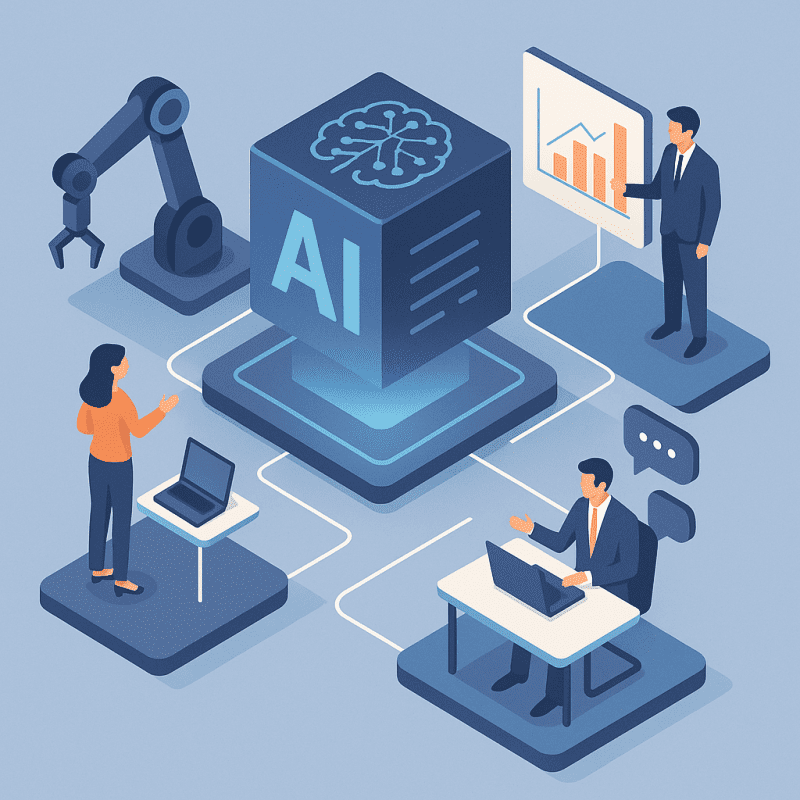Table of Contents Show
Artificial Intelligence (AI) is one of the most transformative technologies of our time. It’s reshaping industries, automating tasks, revealing insights from data, and helping companies deliver new products and services. Yet for all its potential, AI can also be a black hole for time, money, and expectations – especially if leaders dive in without asking the right questions upfront.
If you’re a leader contemplating an AI investment, pause before you sign the check or commission that shiny new project. Here are the crucial questions every leader should ask before investing in AI. Let’s dive in!
1. What Problem Are We Trying to Solve?
Too many AI projects start with the technology (non-AI technology projects also suffer from this!) rather than the problem. “We need some AI in our business” is not a strategy – it’s a recipe for waste.
Key follow-up questions:
- Is this problem frequent and painful enough to justify an AI solution?
- Could it be solved more simply with process changes or traditional software?
- How will we measure the value of solving this problem?
A clear problem statement sharpens focus, aligns stakeholders, and sets realistic goals for your AI initiative. It’s common sense.
2. Do We Have the Right Data?
Data is the fuel for AI. Without enough of it – or without the right kind – you’ll either produce a model that’s inaccurate or no model at all.
Check these data-related issues:
- Do we have sufficient data volume and quality?
- Is the data labeled if required (for supervised learning)?
- Are there legal, ethical, or privacy constraints around using this data?
- Who owns the data, and can we freely use it?
A staggering number of AI projects stall or fail because leaders underestimate the effort and cost of data collection and cleaning. Before investing, know what data you have and what data you’ll need.
3. How Will AI Fit Into Our Workflows?
Even the most brilliant AI solution is useless if it doesn’t integrate into how people actually work.
Consider:
- Where in our business process will AI produce output?
- How will employees interact with it?
- Will it replace tasks, assist with them, or fully automate them?
- What changes in roles or responsibilities will this create?
Leaders should map AI into their operational processes from day one. Otherwise, AI risks becoming a disconnected pilot project that never scales.
4. Do We Understand the Risks?
AI comes with unique risks – some technical, others ethical, legal, or reputational. Leaders must be prepared to manage them.
Types of AI risk:
| Risk Type | Example |
|---|---|
| Data Bias | A model trained only on male applicants might disadvantage women in hiring |
| Lack of Explainability | “Black box” decisions with no transparency |
| Security Risks | Model poisoning or adversarial attacks |
| Compliance Risks | Violating privacy laws like GDPR |
| Reputational Damage | Public backlash if AI makes biased or unfair decisions |
Before investing, leaders should ensure there’s a risk management plan, ethical oversight, and appropriate governance for AI projects.
5. What ROI Are We Expecting – and When?
AI can deliver extraordinary value, but it rarely happens overnight. Many projects take months or even years to train, validate, deploy, and fine-tune. Leaders should be clear-eyed about the timeline and the financial returns.
Ask yourself:
- What are the specific business KPIs AI will improve?
- What cost savings or revenue growth do we expect?
- How long will it take to break even on this investment?
Without clear ROI metrics, AI investments can drift into “science experiments” with no accountability.
6. Do We Have – or Can We Hire – the Right Talent?
AI talent is expensive and scarce. It’s not enough to simply hire a few data scientists; deploying AI often requires:
- Data engineers
- Machine learning engineers
- Domain experts
- MLOps specialists
- Product managers familiar with AI
Leaders should assess whether they have – or can realistically recruit – the skills needed to develop, deploy, and maintain AI solutions.
7. Are We Ready for Change Management?
AI changes how people work, sometimes dramatically. Leaders who ignore the human side of AI adoption are doomed to fail.
Consider:
- How will AI affect job roles?
- Will staff see AI as a threat or a tool?
- What training or support will employees need?
- How will we communicate changes transparently?
A successful AI rollout depends as much on cultural readiness as on technical capability.
8. Are We Complying with Regulations?
AI is increasingly regulated, particularly in industries like healthcare, finance, and government. The EU AI Act, for example, will impose strict rules on “high-risk” AI systems.
Before investing, ask:
- Does our AI project fall into a regulated category?
- Are we prepared to document and explain how our AI works?
- How will we handle customer requests about how their data is used in AI models?
Compliance must be a forethought, not an afterthought.
9. Is There Executive Sponsorship?
AI projects often cut across departmental boundaries. They require resources, political buy-in, and often changes in processes and culture. Without strong executive sponsorship, even the best AI initiatives can die from inertia.
Leaders should ensure:
- There’s a senior champion for the AI initiative.
- Budgets and resources are secured.
- Stakeholders across departments are aligned.
10. Do We Know When Not to Use AI?
Perhaps the most critical question: should we even use AI here?
Some problems simply don’t need AI:
- Low-complexity tasks with existing solutions
- Situations demanding 100% reliability where AI’s probabilistic nature is a liability
- Problems without sufficient data
Good leaders know that sometimes the right decision is not to deploy AI.
Closing Thoughts
AI has immense potential to create business value – but only when pursued thoughtfully. The best leaders don’t chase AI for hype’s sake; they ask tough questions, demand clear business value, and ensure they’re ready for the cultural and operational changes AI brings.
Investing in AI is not simply buying technology. It’s reshaping how your organization thinks, operates, and serves customers. Ask the right questions now, and your AI journey will be far more likely to succeed.
For further reading on how organizations should approach AI adoption, consider:








